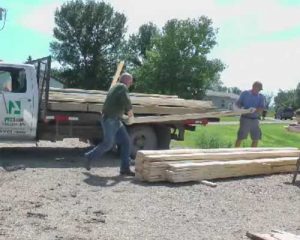Is 2×6 lumber heavy?
 This is actually fairly important, not just to determine how many boards can be toted around a jobsite by one person, but also in calculating the dead loads which must be carried by structural members such as roof trusses and rafters.
This is actually fairly important, not just to determine how many boards can be toted around a jobsite by one person, but also in calculating the dead loads which must be carried by structural members such as roof trusses and rafters.
Like most things played around with by engineers, and other people with too much time on their hands, there is a formula to calculate this (please feel free to scream in anguish now):
62.4 X [ G / (1 + G X 0.009) X (m.c.)] X [1 + m.c./100]
Whoo Hoo!! If this isn’t fun…..like watching paint dry?!
Seriously, it is not so tough. G is the value of the Specific Gravity of a known species of lumber. In the U.S. the most popular choices for framing lumber are Southern Pine (G=0.55), Douglas Fir-Larch (G=0.50), Hem-Fir (G=0.43) and Spruce-Pine-Fir (G=0.42).
The moisture content of the lumber is expressed as the “m.c.” above. Lumber stamped as “dry” has a maximum moisture content of 19%.
Picking Dry Hem-Fir and filling the appropriate blanks into the formula gives, 62.4 * [.43 / (1 + .43 * 0.009 * .19)] * [ 1 + (.19/100)] = 26.86 pcf (pounds per cubic foot). So a 12 inch cube of dry Hem-Fir should weigh 26.86 pounds.
A cubic foot has 1728 cubic inches (ci). 2×6 has finished dimensions of 1-1/2 inches by 5-1/2”, or 99 ci in lineal a foot. Taking the weight calculated above (26.86 pcf) dividing by 1728 and multiplying by 99, gives the weight of a foot of Hem-Fir 2×6 as 1.539 pounds (lbs).
Want to pack around 12 foot long 2×6 lumber? In Hem-Fir, it will weigh 18.466 lbs.
Think of dead loads as the weights of materials which are permanent. In the case of a typical pole barn roof, purlins will always be there supporting the roof sheathing.
If purlins are placed two foot on center, up the slope (or run) of the roof, the dead load attributed to the purlins can be determined by dividing the weight per lineal foot (1.539 lbs calculated above) by the spacing of the purlin (in feet) divided by the cosine of the roof slope. In this case, it is roughly 0.81 psf (pounds per square foot).
Not a lot of weight, but it still must be accounted for. As well, 60% of dead load weight can also be used to counteract the forces of uplift.
So much for the math lesson of the day.
Now, aren’t you glad you asked?






